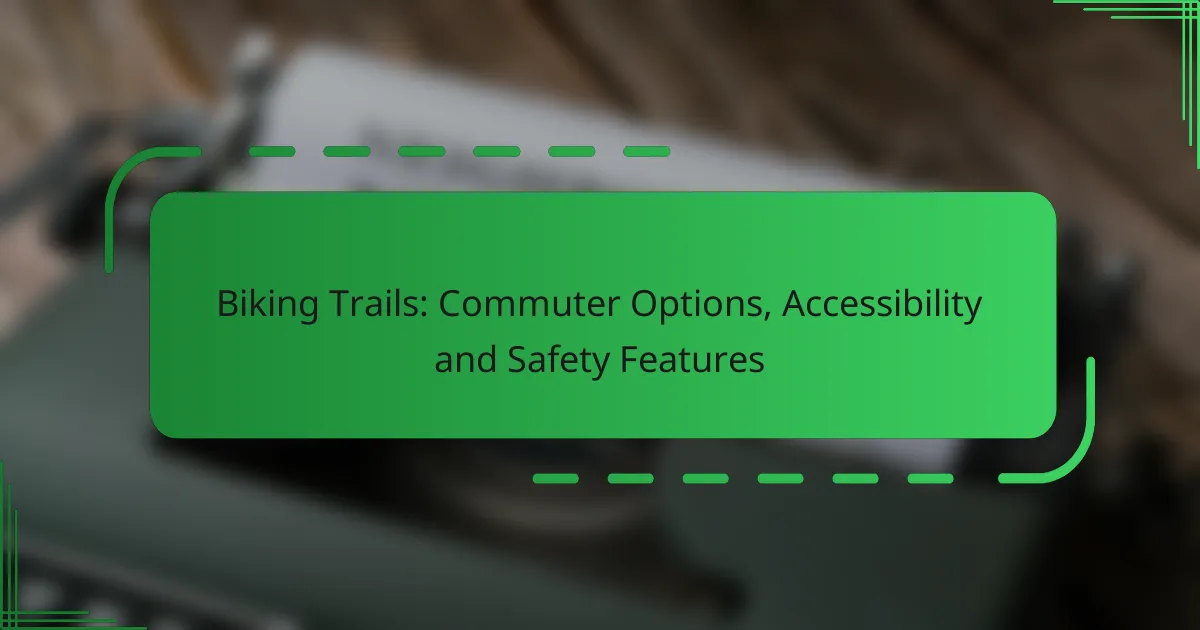Mountain biking trails across the United States provide an exhilarating blend of challenging terrain and breathtaking scenery, catering to riders of all skill levels. From the rocky descents of Moab to the technical climbs of Whistler, these trails offer diverse experiences for both beginners and advanced bikers. Understanding the difficulty of each trail is essential for ensuring a safe and enjoyable ride, allowing enthusiasts to fully appreciate the adventure that awaits.

What are the best mountain biking trails in the United States?
The best mountain biking trails in the United States offer a mix of challenging terrain, stunning scenery, and varying skill levels. Popular destinations like Moab and Whistler attract riders seeking both adventure and breathtaking views.
Moab, Utah
Moab is renowned for its dramatic red rock landscapes and diverse trail options. The Slickrock Trail is a must-ride, featuring challenging technical sections and stunning vistas of the surrounding canyons.
Riders should prepare for steep climbs and descents, with trails ranging from beginner-friendly to expert-only. Always check local conditions and be mindful of weather, as it can change rapidly in this desert environment.
Whistler, British Columbia
Whistler is a premier mountain biking destination, famous for its extensive bike park and scenic alpine trails. The Whistler Bike Park offers trails for all skill levels, from easy green runs to advanced black diamond routes.
Consider purchasing a lift ticket for access to the park, which allows for quick descents and more time on the trails. Be aware of the park’s operating season, typically from late spring to early fall, to plan your visit accordingly.
Park City, Utah
Park City boasts over 450 miles of mountain biking trails, making it one of the most extensive trail networks in the U.S. The Mid Mountain Trail is particularly popular, offering a mix of moderate terrain and beautiful views of the surrounding mountains.
Riders can enjoy a variety of trail conditions, from smooth singletrack to rocky sections. It’s advisable to carry plenty of water and snacks, as some trails can be remote and challenging.
Downieville, California
Downieville is known for its epic downhill trails and stunning river views. The Downieville Downhill is a favorite, featuring a 15-mile descent that combines technical features with flowing sections.
Riders should be prepared for a shuttle service to reach the trailhead, as the climb back up can be strenuous. The best time to visit is during the summer months when trails are dry and accessible.
Kingdom Trails, Vermont
Kingdom Trails offers a unique network of trails that cater to all skill levels, set against the backdrop of Vermont’s picturesque landscapes. The trails are well-maintained and feature a mix of flowy singletrack and technical challenges.
A trail pass is required for access, and it’s recommended to check trail conditions before heading out. The fall season provides stunning foliage views, making it an ideal time for a ride.

How do skill levels affect trail selection?
Skill levels play a crucial role in selecting mountain biking trails, as they determine the rider’s ability to navigate different terrains and obstacles. Beginners should seek out easier trails, while advanced riders can tackle more challenging routes that require greater technical skills and experience.
Beginner trails
Beginner trails are designed for those new to mountain biking, featuring gentle slopes and minimal obstacles. These paths often have well-maintained surfaces and clear signage, making them accessible and safe for novice riders.
Common characteristics of beginner trails include wide paths, gradual inclines, and limited technical features. Riders should look for trails that are less than 5 miles long and have an average incline of around 5-10% to ensure a manageable experience.
Intermediate trails
Intermediate trails present a step up in difficulty, incorporating more varied terrain and obstacles such as rocks, roots, and steeper climbs. These trails require a solid understanding of bike handling and some experience with technical features.
Typically, intermediate trails range from 5 to 15 miles in length and may have inclines of 10-15%. Riders should be prepared for sudden changes in terrain and should practice skills like cornering and braking effectively to navigate these trails safely.
Advanced trails
Advanced trails are intended for experienced riders who are comfortable with challenging terrains and technical features. These paths often include steep descents, narrow passages, and significant elevation changes, requiring a high level of skill and confidence.
Advanced trails can exceed 15 miles and may have inclines greater than 15%. Riders should be equipped with appropriate gear and should always assess their skills against the trail’s demands to avoid accidents or injuries.

What are the most challenging mountain biking terrains?
The most challenging mountain biking terrains include rocky descents, technical climbs, and loose gravel paths. Each type presents unique difficulties that require different skills and techniques to navigate safely and effectively.
Rocky descents
Rocky descents are characterized by steep slopes littered with boulders and loose stones. Riders must have strong braking control and the ability to maneuver around obstacles quickly. It’s crucial to maintain a low center of gravity and keep your weight balanced over the bike to avoid losing control.
When tackling rocky descents, consider using wider tires for better traction and stability. Practice on less challenging trails first to build confidence and skill before attempting more difficult terrains.
Technical climbs
Technical climbs involve steep inclines with obstacles such as roots, rocks, and tight turns. These climbs require not only physical strength but also precise bike handling skills. Riders should focus on maintaining momentum and selecting the right gear to manage the incline effectively.
To improve your ability on technical climbs, practice shifting your weight forward and using your legs to push down on the pedals. Avoid sudden movements that can lead to loss of traction, and consider riding with friends to share tips and techniques.
Loose gravel paths
Loose gravel paths can be unpredictable, as the surface can shift under the tires, making it easy to lose control. Riders need to be cautious and adjust their speed accordingly, especially when cornering. Maintaining a steady grip on the handlebars and using a smooth pedaling technique will help navigate these paths more safely.
To prepare for loose gravel, practice riding on similar surfaces and learn to read the terrain ahead. Keeping your tires properly inflated can also enhance grip and reduce the risk of slipping. Always be aware of your surroundings and anticipate potential hazards.

What scenic views can be found on popular trails?
Popular mountain biking trails offer breathtaking scenic views that enhance the riding experience. Riders can encounter diverse landscapes, from striking rock formations to lush forests, each providing unique visual rewards.
Red rock formations in Moab
Moab is renowned for its stunning red rock formations, which create a dramatic backdrop for mountain biking. Trails like the Slickrock Bike Trail offer riders the chance to navigate over smooth sandstone while enjoying panoramic views of the surrounding canyons.
When biking in Moab, consider the time of day for optimal lighting; early mornings or late afternoons provide the best photographic opportunities. Be prepared for varying terrain, as some trails can be technical and require advanced skills.
Alpine vistas in Whistler
Whistler boasts breathtaking alpine vistas that attract mountain bikers from around the globe. The Whistler Mountain Bike Park features trails that wind through lush forests and ascend to high-altitude viewpoints, offering stunning views of the surrounding mountains and valleys.
To fully appreciate the scenery, plan your ride during the summer months when the weather is milder. Keep an eye out for wildlife, as the area is home to various species, adding to the natural beauty of the experience.
Forest landscapes in Kingdom Trails
Kingdom Trails in Vermont is famous for its picturesque forest landscapes, characterized by dense woodlands and serene lakes. The network of trails here caters to all skill levels, making it an ideal destination for families and seasoned riders alike.
Riders should take advantage of the well-marked trails and consider a guided tour to learn more about the local flora and fauna. The fall season is particularly stunning, as the foliage transforms into vibrant colors, enhancing the already beautiful surroundings.

What gear is essential for mountain biking?
Essential gear for mountain biking includes a suitable bike, protective equipment, and maintenance tools. A well-fitted mountain bike tailored to your riding style and terrain is crucial, along with gear that ensures safety and comfort during your rides.
Mountain bike types
Mountain bikes come in various types, each designed for specific terrains and riding styles. Common categories include cross-country bikes, which are lightweight and efficient for climbing; trail bikes, which offer a balance of climbing and descending capabilities; and downhill bikes, built for steep descents and rugged terrain.
When choosing a mountain bike, consider factors such as suspension type (hardtail vs. full suspension), wheel size (26″, 27.5″, or 29″), and frame geometry. Each choice affects handling, speed, and comfort on different trails.
Protective gear
Protective gear is vital for safety while mountain biking. Essential items include a well-fitted helmet, gloves, knee and elbow pads, and appropriate footwear. These items help minimize injury risk in case of falls or accidents.
When selecting protective gear, ensure it meets safety standards and fits comfortably. For instance, a helmet should be snug but not overly tight, and pads should allow for mobility while providing adequate coverage. Investing in quality gear can significantly enhance your riding experience and safety on challenging trails.



